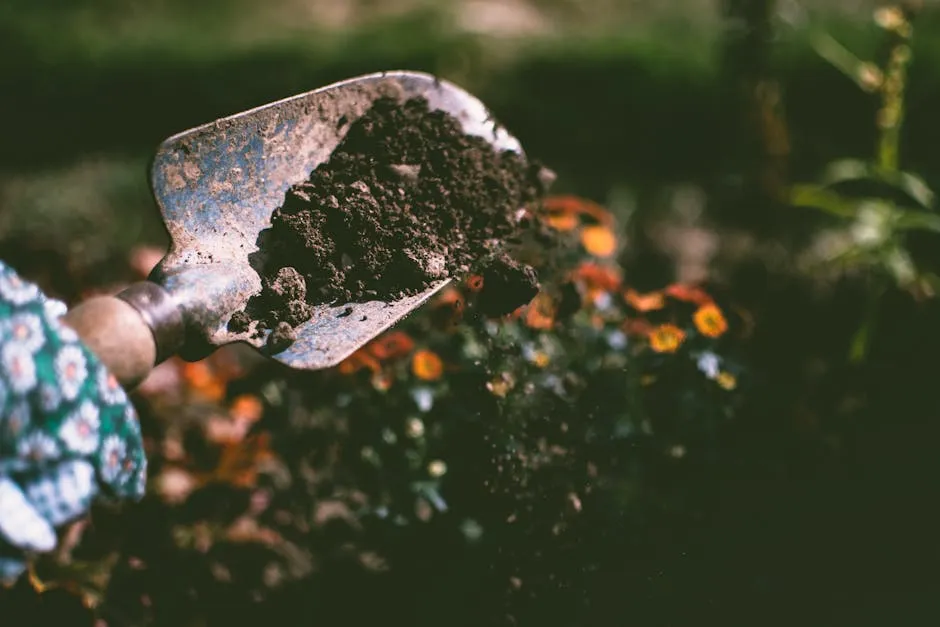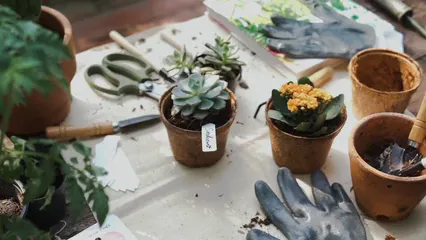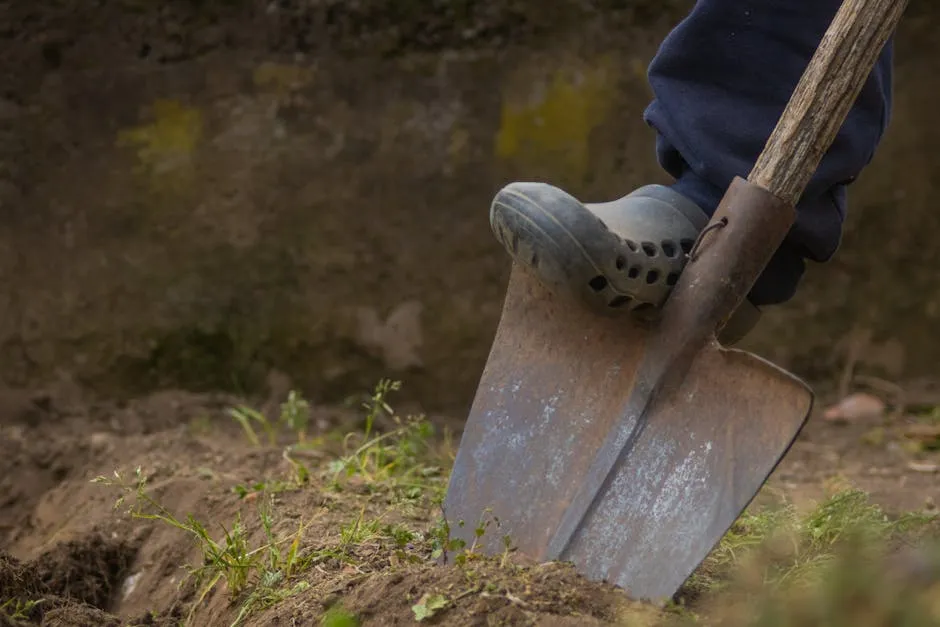

Planting Shovel: Your Ultimate Guide to Choosing the Right Tool for Your Garden
Introduction
Are you passionate about gardening? If so, you know the importance of the right tools. One essential tool is the planting shovel. This handy device plays a crucial role in planting, transplanting, and maintaining your garden. In this article, we aim to help you understand the different types of planting shovels, their uses, and best practices for selecting the right one for your needs.
Speaking of essential tools, have you checked out the BLACK+DECKER 20V MAX Cordless Lithium-Ion 2.0 Ah Battery and Charger? This battery is a game changer for all your cordless tools, ensuring you never miss a beat in your gardening adventures!
Summary and Overview
A planting shovel is a specialized tool designed for digging and planting. Its significance in gardening cannot be overstated. It’s perfect for creating holes for seeds, bulbs, or young plants and can make your gardening tasks easier and more efficient.
There are several types of planting shovels available, each with unique materials and designs. When choosing a planting shovel, consider important features like grip type, size, and durability. And if you’re looking for a reliable tool, the Spear & Jackson 4″ Carbon Steel Hand Trowel is a fantastic choice for precision digging!
In the following sections, we’ll cover the various types of planting shovels, including standard and specialty options, as well as ergonomic designs. We’ll also discuss materials used in shovels and key features to consider when making your selection.

Types of Planting Shovels
Standard Planting Shovels
Standard planting shovels are the go-to option for many gardeners. These versatile tools typically feature a broad blade, making them ideal for digging and planting. The blade size usually ranges from 6 to 12 inches, allowing you to create holes of various sizes.
Handles come in different types, including D-grip and T-grip, which offer varying degrees of control and comfort. Materials can include steel or aluminum, with some shovels featuring wooden handles for a classic feel. If you’re looking for a sturdy option, check out the Bushpro Speed Spade. It’s built for rigorous planting tasks!
Standard planting shovels are perfect for general gardening tasks, such as planting flowers, vegetables, or small trees. Their durability and ease of use make them a staple in any gardener’s toolkit.

Specialty Planting Shovels
Specialty planting shovels cater to specific gardening tasks. For instance, bulb planting shovels have narrower blades designed for digging precise holes for bulbs. Their unique shape makes it easier to create the right depth without disturbing surrounding soil.
Tree planting shovels, on the other hand, are sturdier and often feature a longer handle, providing better leverage for digging deeper holes. Some models come with reinforced blades to handle tougher soil conditions. If you’re serious about planting trees, consider the Manutan Wide Planting Shovel—it’s great for heavy-duty use!
These specialty tools can greatly enhance your gardening experience by making specific tasks easier and more efficient. Whether you’re planting bulbs or young trees, having the right specialty shovel can make all the difference.

Ergonomic Shovels
When it comes to gardening tools, ergonomics matters. An ergonomic shovel can significantly enhance your gardening experience. It helps prevent strain and discomfort, especially during long sessions of digging and planting.
Look for features like comfort grips. These grips reduce pressure on your hands and wrists. Lightweight materials also play a crucial role. A lighter shovel means less fatigue as you work. The Fiskars 384490-1001 Ergo Trowel is a great example of an ergonomic tool designed for comfort!
Using ergonomic shovels can lead to better posture. They promote a natural stance, reducing the risk of back pain. With these tools, you can enjoy gardening without the aches and pains that often accompany it. Investing in ergonomic designs is a smart choice for any gardener looking to improve their toolset.

Materials Used in Planting Shovels
Steel vs. Aluminum
Choosing between steel and aluminum for your planting shovel can be tricky. Steel shovels are known for their durability. They can withstand heavy use and tough soil conditions. However, they can be heavier, which might cause fatigue during extended use.
On the other hand, aluminum shovels are lightweight and easy to handle. This makes them ideal for frequent use, especially for tasks that require precision. However, they may not be as durable as steel, especially in rocky soil. If you’re looking for a lightweight option, the Radius Garden 203 Pro Ergonomic Hand Trowel is a fantastic choice!
Cost is another factor. Steel shovels tend to be more expensive due to their durability. Aluminum options are often more budget-friendly but may need replacing sooner. Weighing durability, weight, and cost will help you decide which material suits your gardening needs best.

Wooden Handles vs. Composite Handles
When selecting a planting shovel, consider the handle material. Wooden handles offer a classic feel and natural grip. They can be very comfortable to use, especially if you prefer traditional tools. However, wood requires more maintenance to keep it in good condition.
Composite handles, on the other hand, are often more durable. They resist weathering and don’t splinter like wood can. This means less upkeep, making them a practical choice for busy gardeners. If you’re looking for a hassle-free option, check out the DeWalt DWO1DT995 15″ Steel Garden Tiller—it’s built to last!
Comfort is also a factor. Some gardeners find wooden handles warmer and more pleasant to grip. Others prefer composite for its sturdiness and reliability. Ultimately, your choice should align with your gardening style and maintenance preferences.
Features to Consider When Choosing a Planting Shovel
Blade Shape and Size
The shape and size of a shovel’s blade can make a big difference. A wider blade can move more soil, making it efficient for large areas. Conversely, a narrower blade is suited for precision work, like digging holes for individual plants.
Choosing the right size is essential too. A larger blade may be cumbersome in tight spaces, while a smaller blade may require more effort for bigger tasks. Think about your gardening needs and the types of plants you’ll be working with. You might also want to consider the Gardena 8930-20 Classic Garden Hose for watering your plants efficiently!
Selecting the appropriate blade shape and size can enhance your planting efficiency. It ensures you have the right tool for each gardening task, making your work smoother and more enjoyable.

Handle Length and Grip Type
Choosing the right handle length for your planting shovel is key. It affects how comfortably you can work with the tool. Taller gardeners may prefer longer handles, while shorter users benefit from shorter ones. This ensures you can dig without straining your back.
Grip types also play a significant role in user experience. D-grips provide excellent control and are ideal for digging. They allow for more leverage and power. On the other hand, T-grips are great for pushing and shoveling. They offer a comfortable hold for extended use. If you want to keep your hands clean, consider using Gardening Gloves with Fingertips—they’re perfect for maintaining your garden!
Ultimately, consider your height and preferred gardening style. Testing different lengths and grips can help you find the perfect fit. The right handle can make your gardening tasks easier and more enjoyable.

Best Practices for Using a Planting Shovel
Proper Digging Techniques
Using a planting shovel effectively can save time and energy. Start with a firm stance, feet shoulder-width apart. Position the shovel blade at a slight angle to the ground. This helps with penetration.
Next, apply your weight onto the shovel handle, pushing it into the soil. For deeper holes, wiggle the shovel back and forth to break up compacted soil. Avoid heavy lifting; instead, use your legs to push down, maintaining a straight back.
When removing soil, scoop it out by tilting the shovel slightly. This technique improves efficiency and reduces strain on your arms. Always remember to change positions frequently to avoid fatigue.

Maintenance Tips
Caring for your planting shovel extends its lifespan. After each use, clean the blade with water and a brush to remove dirt. A quick wipe with a cloth helps prevent rust.
Store your shovel in a dry place, ideally hanging or on a rack. This keeps it off the ground and prevents damage. Regularly check the blade for nicks or dullness. Sharpening it ensures effective digging. If you want to ensure your soil is in top shape, consider using the Luster Leaf 1601 Rapitest Soil Test Kit—it’s a great way to monitor your garden’s health!
Additionally, inspect the handle for any cracks or splinters. Addressing these issues early can prevent accidents. A well-maintained shovel makes your gardening tasks easier and more enjoyable.

Popular Brands and Recommendations
Overview of Trusted Brands
When choosing a planting shovel, consider reputable brands. BLACK+DECKER offers a range of durable options. Their shovels often feature ergonomic designs to reduce strain. If you’re looking to invest in a reliable tool, you might want to check out the Miracle-Gro Water Soluble All Purpose Plant Food—it’s perfect for keeping your plants healthy!
Spear & Jackson is another trusted name. They provide a mix of traditional and modern tools known for their quality. Their planting shovels often come with comfortable grips and sturdy blades.
Look for brands that offer warranties. This often indicates confidence in their products. With reliable brands, you can find the perfect planting shovel for your gardening needs.

Top Recommendations for Various Needs
When selecting a planting shovel, your specific gardening needs matter. For beginners, the BLACK+DECKER Shovel is an excellent choice. Priced around €21.99, it features a comfortable grip and a durable stainless-steel blade. You can easily find it on Amazon.
For heavy-duty use, consider the Bushpro Speed Spade. This robust tool retails for about $75.95 CAD and is designed for rigorous planting tasks. Its stainless-steel construction offers longevity and reliability.
If you’re looking for a budget-friendly option, check out the Garden Kneeler and Seat with Tool Bag available for only €5.63. It features a bi-material handle for comfort and is great for simple gardening tasks.
Finally, for eco-conscious gardeners, the Green Planting Shovel is a fantastic option at €18.90. Made from FSC-certified birch wood, it’s not only functional but sustainable. You can find it on various gardening websites.

FAQs
What is the difference between a planting shovel and a regular shovel?
A planting shovel is designed for digging small holes and transplanting. It usually has a narrower blade and a shorter handle for better control, unlike regular shovels, which are broader and meant for heavier lifting.
How do I choose the best planting shovel for my garden?
Consider your gardening style and tasks. If you often dig small holes for plants, opt for a narrow blade. For larger plants or trees, a sturdier shovel with a broader blade works best.
Are ergonomic shovels worth the investment?
Yes! Ergonomic shovels reduce strain on your body. They often feature comfortable grips and lightweight materials, making long gardening sessions more enjoyable.
How often should I sharpen my planting shovel?
Aim to sharpen your shovel after every season. Regular maintenance keeps the blade effective, making digging easier and prolonging the tool’s lifespan.
Can I use a planting shovel for other gardening tasks?
Absolutely! While they excel at planting, planting shovels can also assist with light weeding and soil turning, making them versatile tools in your gardening arsenal.
Please let us know what you think about our content by leaving a comment down below!
Thank you for reading till here 🙂
To ensure your plants thrive, it’s essential to follow seasonal maintenance tips for self-watering container gardens in fall 2024.
For successful gardening, understanding how to improve soil nutrients for successful plant transplanting is vital.
All images from Pexels



